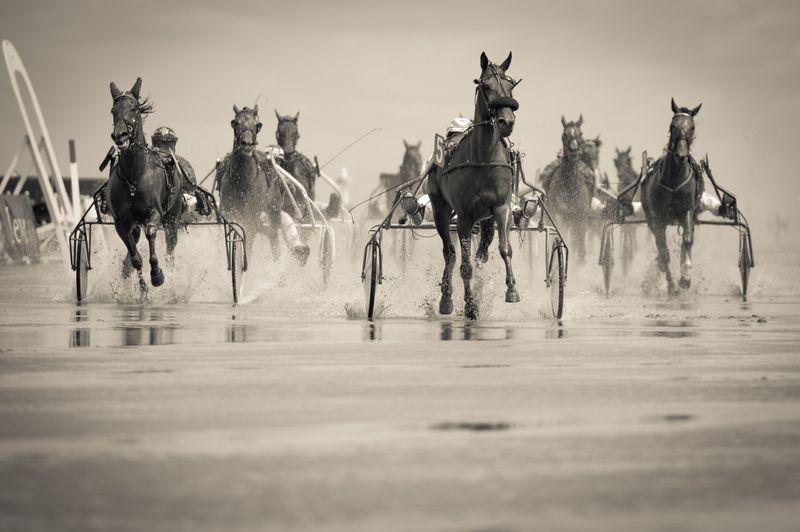Silverstone Speed Trap: Who is the Fastest of Them All?
The Importance of Maximum Velocity and Overall Performance in F1
Silverstone, Britain’s renowned temple of speed, is a circuit that demands more than just raw top speed from Formula 1 cars. With its combination of high-speed straights and challenging corners, the fifth longest circuit on the calendar requires a well-rounded car and a finely-tuned aerodynamic setup for optimal performance. While maximum velocity is undoubtedly crucial, it is not the sole factor in determining a car’s overall ability on this track.
Teams often opt for medium to high-downforce configurations at Silverstone. This allows their cars to generate maximum downforce through the high-speed corners while minimizing drag on the long straights. Balancing these two aspects is key to achieving the perfect combination of top speed and cornering power.
An Analysis of Speeds and Lap Times
Examining the numbers recorded down Hanger Straight, it becomes clear that top speed alone does not guarantee success. Fernando Alonso’s Aston Martin blitzed through the speed trap at an impressive 327.2 km/h, placing him at the forefront in terms of pure velocity. However, he only managed to secure the ninth fastest time in Q3.
In contrast, pole-sitter Max Verstappen in the Red Bull RB19 was just 1.1 km/h slower than Alonso in terms of top speed but managed to be 0.939 seconds faster over an entire lap. This data highlights the superiority of Red Bull’s aerodynamic efficiency and demonstrates the significance of an all-encompassing performance that balances top speed and cornering prowess.
Forecast for the Race
With Verstappen’s dominating performance in qualifying, it appears that he is primed for another successful race. His main challengers, led by McLaren’s rising stars, will undoubtedly fiercely battle among themselves for the remaining podium positions. However, whether they can mount a significant challenge to Verstappen remains to be seen.
Tyre degradation and strategy are likely to be influential factors in the race’s outcome. Silverstone is notorious for its impact on a car’s tyres, with the left-front tire being subjected to immense loads through a majority of the corners. Last year, a two-stop race was the norm, albeit influenced by a late-race Safety Car. McLaren’s data suggests that a one-stop strategy may be more favorable this time around.
Nevertheless, barring any unforeseen incidents, it is safe to assume that Max Verstappen will maintain control of the race. His exceptional performance in qualifying, paired with Red Bull’s exceptional aerodynamics, provides a formidable combination that is hard to challenge.
Philosophical Reflections: The Intersection of Speed, Aerodynamics, and Strategy
Formula 1 is the epitome of relentless pursuit in the field of motorsports. It requires teams to constantly explore the delicate balance between speed, aerodynamics, and strategy.
In the quest for speed, engineers and drivers are challenged to maximize the velocity of their cars while maintaining stability and control. The circuit at Silverstone further magnifies this challenge, exposing the limitations of focusing solely on outright speed. The delicate interplay between high-speed cornering and straight-line acceleration demands a holistic approach to car design and setup. The ultimate goal is to find the perfect equilibrium that leads to a successful lap time.
Aerodynamics plays a pivotal role in achieving this balance. By manipulating airflows around the car, teams can generate downforce to enhance cornering grip while minimizing drag for faster straight-line speed. The ability to strike the optimal compromise between downforce and drag is the key to success on a circuit like Silverstone.
Furthermore, strategy adds another layer of complexity to the mix. The management of tire degradation and the selection of pit-stop strategies can significantly impact race outcomes. A shrewd strategical decision can turn the tide in an instant.
In essence, the world of Formula 1 exemplifies the convergence of science, engineering, and human skill. It requires a broad understanding of physics, aerodynamics, and tire management, all while pushing the boundaries of what is technologically and physically possible.
An Editorial: The Pinnacle of Racing Excellence
The Silverstone Speed Trap incident offers a profound insight into the spectacular world of Formula 1. It epitomizes the essence of motorsport, where speed, technology, strategy, and human talent collide.
The relentless pursuit of excellence in Formula 1 is an unending battle. Reigning supreme involves a constant analysis of car performance, tire management, and strategic decision-making. It is a perpetual process of refining and optimizing every aspect of the racing experience.
As fans, we bear witness to a captivating display of human ingenuity, exceptional driving skills, and tactical brilliance. Formula 1 encapsulates the epitome of sporting achievement and serves as a testament to the relentless pursuit of excellence in human endeavor.
In the end, the question of who is the fastest of them all may be secondary to the broader beauty and essence of the sport. It is about the continuous evolution and pursuit of perfection in the realm of racing. Formula 1 embodies the spirit of pushing boundaries, of capturing the imagination, and of transcending the limits of what is believed possible.
Advice to Aspiring Racers and Formula 1 Enthusiasts
For aspiring racing drivers and Formula 1 enthusiasts, the Silverstone Speed Trap incident provides valuable lessons and inspiration.
Firstly, the incident reminds us that pure speed alone is an incomplete measure of success. Success in motorsport is the culmination of a finely tuned balance of speed, aerodynamics, and strategy. To succeed in Formula 1, aspiring racers must focus on honing their skills across all these dimensions.
Secondly, the Silverstone Speed Trap serves as a reminder that success in racing requires a holistic and multidisciplinary approach. Aspiring drivers should not only focus on raw speed but also develop a deep understanding of aerodynamics, tire management, and race strategy.
Lastly, this incident underscores the importance of relentless pursuit and never settling for mediocrity. Formula 1 is a constant battle to improve and optimize performance at every level. Aspiring racers should adopt a mindset of continuous improvement, constantly pushing boundaries, and striving for excellence.
In conclusion, the Silverstone Speed Trap incident offers us a glimpse into the mesmerizing world of Formula 1. It reminds us that while speed is essential, it is the intricate interplay of various factors that ultimately determines success in racing. Formula 1 represents the pinnacle of driving excellence, a never-ending pursuit of perfection that captivates fans and pushes drivers to the limits of their abilities. Aspiring racers and enthusiasts can draw valuable lessons from this incident and find inspiration in the relentless pursuit of excellence that defines the world of Formula 1.

<< photo by cottonbro studio >>
The image is for illustrative purposes only and does not depict the actual situation.
You might want to read !
- Revving Up: Is Ferrari Ready to Roar Past Red Bull in the Fast Lane?
- Revolution on Wheels: Australian Racer Stuns F1 World
- Oscar Piastri leads astounding McLaren triumph: An extraordinary achievement
- Australian NASCAR Driver SVG Leaves Audience Astonished with Lightning-Fast Performance
- Tragedy at Spa: The Untimely Death of 18-year-old Dilano van ‘t Hoff
- Supreme LeBrocq showcases heroic skills, secures pole position as torched Mustang saved




